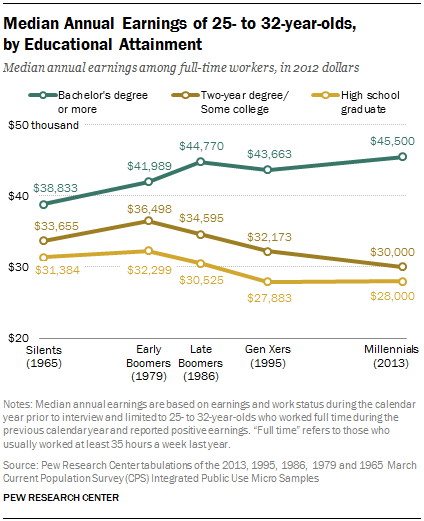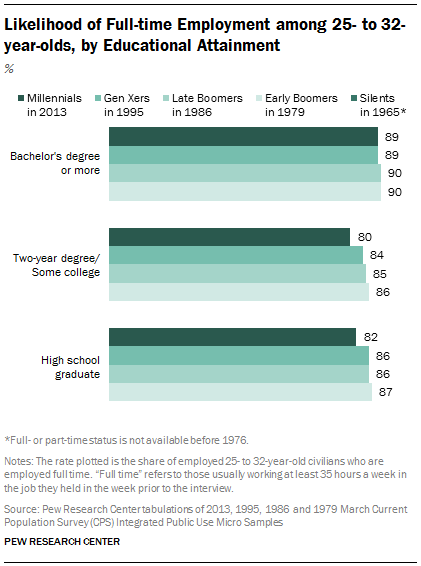The new Build Dakota vo-tech scholarship that Governor Dennis Daugaard and usury-billionaire T. Denny Sanford want to create is based on the argument that not enough South Dakota youngsters are going to vo-tech schools. The scholarship further assumes that if we wave money at students, they'll go to vo-tech and work in South Dakota for three years.
But if dollar signs are the deciders, young people will say no thank you to those two-year degrees and stick with college. Let's look at two charts from a Pew Research February 2014 report titled The Rising Cost of Not Going to College.
First, consider how young workers' median income by education level has changed over the last 50 years:
Whether young workers had four-year degrees, two-year degrees, or mere high school diplomas, they all enjoyed an increase in earning power from 1965 to 1979. Then the Reagan Revolution turned that curve downward for folks without a four-year degree. Between 1965 and 2013, folks with two-year degrees or "some college" gave up 11% of their earning power. So did workers who stopped with high school diplomas. Only four-year degree holders posted a gain (17%). Most of the college-degree holders' gain happened before 1986, but they're still far ahead of folks with two-year degrees or less. According to this chart, the two-year degree boosts median income only 7% over HS diploma levels; the four-year degree boosts median income 62% over HS diploma levels.
The $15,500 gap between median incomes for college grads and two-year/non-grads is more than the $15,000 value I assumed for the Build Dakota Scholarship in my state-vs-state payoff calculations. It's more than the $9K–$12K range for one-year degrees but less than the $16K–$20K range for two-year degrees provided by the state. That $15.5K gap every year is enough to allow a student who chooses college instead of vo-tech to pay off the average South Dakota student's debt in two years.
Contrary to Governor Daugaard's constant warnings of the unemployability of four-year degree holders, college grads still have an edge in landing jobs:
These numbers show that folks of all education levels are having a little harder time finding work. But in 2013, 89% of four-year degree holders had full-time gigs. Among the two-year/come college crowd, that success rate was 80%.
Of particular interest is the fact that Pew found mere high school grads enjoying a tick or two more full-time employment than their two-year/some college counterparts.
Now don't get too excited: that "two-year/some college" category includes both two-year degree completers and kids who major in beer before dropping out with no paper in hand. Break those subgroups apart, as David Leonhardt did for the NYT Upshot last May, and you find those two-year achievers outperforming the beer-flavored dropouts. But even the figures Leonhardt gets from the Bureau of Labor Statistics show higher employment among four-year degree holders than vocational two-year degree holders.
If the Build Dakota Scholarships are meant to encourage high school graduates who would otherwise forgo further education to get a vo-tech degree, then they are a good idea. But if these scholarships are targeted at students deciding between vo-tech and college degrees, they are enticing students toward significantly lower earning potential and slightly lower employment possibilities.



I will say this so all you can republicans can understand this its comes to down to wages, you dont want to pay your teachers.When children graduate they boogie out of the state to get better teaching jobs or manufacturing rocket science to you I know.Then they want to pay low wages .
So let me get this right. High school graduates will get a free vo-tech education if they're willing to stay in SD for three years after obtaining their skill. Then, at age 23 or so, they'll be willing to commit a big chunk, if not all, of their futures in SD instead of skeedaddling to other states where their skills are more highly valued. And they'll choose to remain in SD because . . . ?
John, are you trying to encourage young people to think like hard-headed business owners? Don't confuse the kids! ;-)
Build Dakota might be better suited for individuals with disabilities who are not eligible for Voc. Rehab. services, and a college degree (depending on the field,) is too difficult to earn.
Those who are in the 40 - 50 years old range who have lost their employment, for whatever reason.
Or, those who had been in prison for non-violent crimes, and out of the workforce for a few years, or have poor employment histories.
That is not going to happen, but just think that someone who has been in prison might have a better chance of succeeding in not returning to prison if they have training in a trade. Some of those guys are physically strong, and have worked in less than desirable situations, such as cleaning the cages at the humane society, helping with the clean-up after a storm etc.
"cleaning the cages of the HUMAN society"